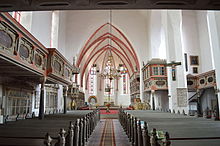City Church St. Marien (Weida)
The town church “St. Marien “Weida is the Protestant town church of Weida . It is located on the Weida river of the same name , is built in the Gothic style and was once the church of a Franciscan monastery .
history
Originally, the city had two parish churches, corresponding to the two halves of the city, the old town and the new town, with their own rights. The church in the old town was the church of St. Mary on the same level - called " Widenkirche ", of which the tower and the ruins of the nave are still standing today. The New Town Church is dedicated to the Apostle Peter . It stands near the market. Only remnants of her and the tower are still preserved. The five bells of the parish hang on the two towers of these church ruins - two bells from the Widenkirche and three from the tower of the Peterskirche.
The city also housed two monasteries: a Franciscan monastery , which belonged to the Saxon Franciscan Province ( Saxonia ), and a Dominican convent . With the introduction of the Reformation and the unification of the two halves of the city into one parish, the Franciscan monastery church was elevated to the rank of city parish church.
The Franciscans and their chapel in Weida are first mentioned in a document in 1267. In 1350 they began to convert the chapel dedicated to Our Lady into a monastery church. The Franciscans usually build their churches without a tower, in the style of a mendicant order church . An old stitch suggests that there was once a roof turret. Around 1450 the church was extended by a side aisle. The monastery was dissolved as a result of the Reformation , when the pastor Johannes Gülden began to preach Martin Luther's meaning in 1524 . Luther himself preached in Weida on October 8, 1530.
On August 9, 1633, the Adelhof cavalry regiment of the Holk army attacked Weida and burned the Osterburg and the town down to a few houses, including the town church. From 1644 to 1650, the reconstruction was driven forward under the direction of the superintendent Johannes Francke . Pulpit, baptismal font (both richly decorated with carved figures), altar crucifix, coffered ceiling, galleries and bourgeois stalls of the town church go back to this time. In 1704, the painter Paul Läber created 54 pictures in the galleries based on motifs from the Bible. The organ, the prospectus of which dates from 1762, was installed in 1934 by the Walker company. In the same year the vault over the choir was restored. The most valuable work of art in the town church is a fresco with the death of Mary, it was originally part of a cycle of Mary in the Widenkirche.
Weidaer Flood Bible
On August 6th and 7th, 1661, after persistent rain, the river Weida caused so much flooding that the Katsch Bridge in the old town and some houses were torn away. This driftwood lay down in front of the stone church bridge (connecting the old and new town) and dammed the river in such a way that it overran its banks and made its way through the old town and the town church. The chronicler reports: “The river was so swollen that when the church door was pushed open it filled the wide space four cubits high (approx. 2.25 m), the Bible thrown from the Epistle chair (lectern) in the excrement and mud, its allied frets completely spoiled and the chorus threatened to break through ”. The altar Bible was carried away by the water, found days later at the weir of the Mildenfurth monastery and restored in Gera. Since those events it has been called the “Weida Flood Bible”.
present
The city church was included in the urban development program of the State Office for Monument Protection and has been renovated since then. There are regular musical events, church services and church meetings. In the outbuildings there are meeting places for people with disabilities and social services.
Web links
Coordinates: 50 ° 46 ′ 19.7 ″ N , 12 ° 3 ′ 41.6 ″ E



